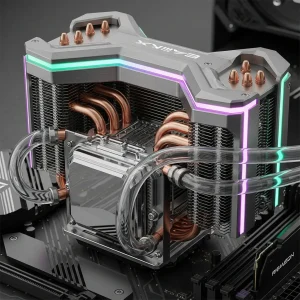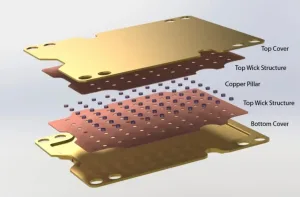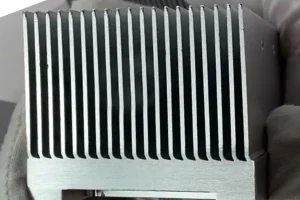Exploring the Benefits of a Heat Pipe Heat Sink for Efficient Cooling
Introduction
In today’s electronics and industrial sectors, efficient cooling isn’t just an option—it’s essential for ensuring performance, reliability, and product longevity. As devices grow more compact and powerful, managing heat becomes increasingly challenging. Traditional cooling methods often fall short. That’s where heat pipe technology steps in, offering an innovative solution with superior thermal conductivity. In this article, we’ll explore the key benefits of using a heat pipe heat sink, and why it’s considered an ideal choice for efficient thermal management.
Overview of Heat Pipe Technology
How Heat Pipes Work
A heat pipe is a highly efficient thermal transfer device. It leverages the phase change of a working fluid—such as water, ammonia, or methanol—inside a sealed system. Here’s how it functions:
Evaporation: Heat applied to one end (the evaporator section) causes the working fluid to vaporize.
Vapor Transport: The vapor rapidly travels through the pipe to the cooler end (the condenser section).
Condensation: The vapor condenses back into liquid, releasing its latent heat.
Return Flow: Capillary action within the wick structure returns the liquid to the evaporator, completing a continuous heat transfer cycle.
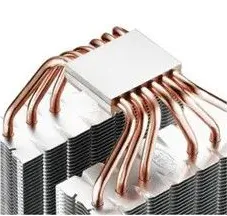
Why Efficient Cooling Matters
In electronic devices, excessive heat can lead to reduced chip performance, instability, or even permanent damage. Industrial equipment faces similar risks—high temperatures can impact production efficiency and shorten equipment lifespan. Adopting reliable cooling solutions like a heat pipe heat sink helps maintain optimal operating temperatures, extending product life while preserving peak performance.
Understanding Heat Pipe Heat Sinks
How a Heat Pipe Heat Sink Works
A heat pipe heat sink combines heat pipes with cooling fins. The heat pipes efficiently transport heat away from the source, while the fins disperse it into the surrounding air. This synergy drastically improves thermal efficiency, especially in applications where space is limited or where high heat flux is present.
Key Components of a Heat Pipe Heat Sink
Heat Pipes: The core thermal transfer elements.
Heat Spreader/Base Plate: Interfaces directly with the heat source, channeling heat into the pipes.
Cooling Fins: Usually made from aluminum or copper, maximizing the surface area for heat dissipation.
Mounting Structures: Securely integrate all components.
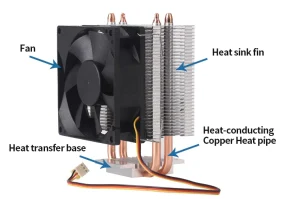
Key Benefits of Heat Pipe Heat Sinks
Improved Thermal Performance
The standout feature of a heat pipe heat sink is its exceptional thermal conductivity. Thanks to phase-change heat transfer, its effective thermal conductivity is significantly higher than that of solid metals like copper or aluminum. This allows for rapid heat transfer from the source to the dissipating fins, maintaining lower component temperatures.
Space Efficiency
Compared to bulky traditional heat sinks, heat pipe heat sinks offer more compact designs. Their flexible configuration makes them ideal for use in laptops, smartphones, and other miniaturized electronics where space is at a premium.
Durability and Reliability
Since heat pipes are sealed, passive systems with no moving parts, they are highly reliable and durable. Once manufactured and sealed, a heat pipe heat sink can maintain stable performance over years of use, with minimal impact from environmental factors.
What is a Heat Pipe Heat Sink?
Definition and Functionality
A heat pipe heat sink is an advanced cooling device that combines heat pipes with cooling fins to efficiently transfer and dissipate heat. It’s commonly used to cool components like CPUs, GPUs, LEDs, and power electronics, keeping them within safe operating temperatures via convection and radiation.
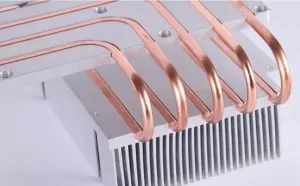
Comparison with Traditional Heat Sinks
Unlike solid metal heat sinks that rely solely on the thermal conductivity of materials like copper, heat pipe heat sinks use phase-change heat transfer. This method can be hundreds or even thousands of times more efficient than metal alone. Additionally, they often offer lighter and thinner profiles, providing an ideal balance between performance and size.
Types of Heat Pipe Heat Sinks
Active vs. Passive Cooling Systems
Passive Cooling System: Relies entirely on natural convection and radiation without fans. Heat pipes transfer heat to cooling fins, which release it into the environment quietly and energy-efficiently. Ideal for low-noise, high-reliability applications such as medical equipment and telecom stations.
Active Cooling System: Combines heat pipes with fans to force airflow across the fins. This dramatically increases heat dissipation capacity, making it suitable for high heat flux applications like gaming PCs and servers.
Advantages of Using a Heat Pipe Heat Sink
Enhanced Thermal Conductivity
The primary advantage of heat pipe heat sinks lies in their extremely high effective thermal conductivity. They rapidly spread heat across the entire heat sink surface, ensuring even temperature distribution and preventing hot spots.
Lightweight and Compact Design
The structural properties of heat pipes allow for lighter, more compact cooling systems. This is crucial for modern portable electronics and applications where space-saving is essential.
Passive Cooling System Benefits
In certain scenarios, passive cooling is ideal. Heat pipe heat sinks excel here as they eliminate the need for fans, avoiding noise, vibration, and power consumption. This is especially valuable in sensitive environments such as healthcare facilities and industrial control systems.
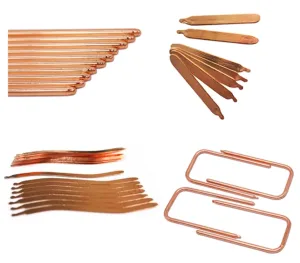
Applications of Heat Pipe Heat Sinks
Heat Pipe Applications in Electronics
Heat pipe heat sinks are widely used in various electronic devices, including:
Laptops and Ultrabooks: Managing CPU and GPU heat in slim form factors.
Smartphones and Tablets: Achieving effective cooling in ultra-thin devices.
Servers and Data Centers: Enhancing system reliability and thermal performance.
LED Lighting: Extending LED lifespan and improving luminous efficiency.
Gaming Consoles and High-Performance Desktops: Managing high thermal loads from advanced processors and graphics cards.
Industrial Uses and Custom Solutions
Beyond consumer electronics, heat pipe heat sinks play a critical role in industries such as:
Power Electronics: Cooling inverters and variable frequency drives.
Industrial Control Systems: Ensuring stable operation in harsh environments.
Electric Vehicles: Managing battery packs and motor controllers.
Custom Heat Sink Assemblies: Tailored designs based on device size, heat source location, and specific cooling requirements.
Heat Sink for Soldering Copper Pipe
In specialized applications like copper pipe soldering, heat pipe heat sinks can be designed for localized cooling. Precision soldering requires strict temperature control to avoid overheating and material deformation. Compact heat pipe heat sinks help absorb excess heat quickly, improving soldering quality and reliability.
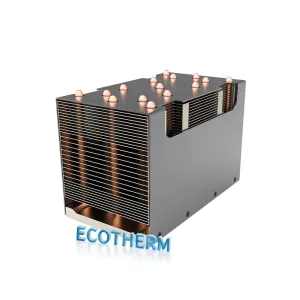
Conclusion
Summary of Benefits
A heat pipe heat sink stands out as a go-to solution for modern thermal management needs. With superior heat transfer performance, compact form factor, high reliability, and adaptability to both active and passive cooling systems, it’s an indispensable component in both consumer electronics and industrial applications.
Future Trends in Heat Pipe Technology
As electronics continue evolving towards higher power and smaller sizes, heat pipe technology is poised for further innovation:
Thinner, More Flexible Heat Pipes: Enabling even more compact designs and wearables.
Micro Heat Pipes and Microchannel Cooling: Targeting chip-level thermal management.
AI-Integrated Thermal Management Systems: Smarter, more precise temperature control.
New Working Fluids and Wick Materials: Expanding performance in extreme temperature environments.
Heat pipe heat sinks aren’t just keeping up—they’re shaping the future of electronic cooling solutions.

